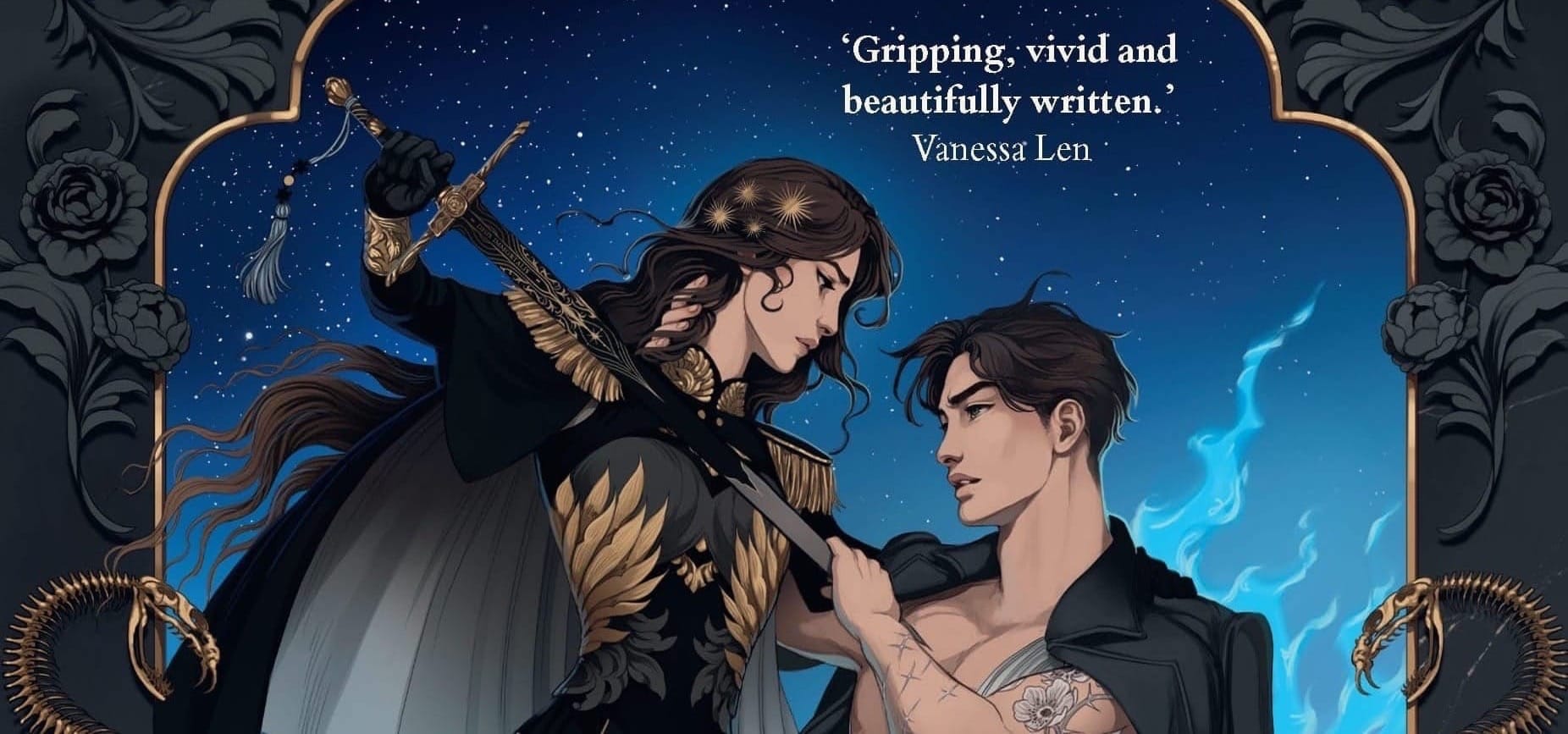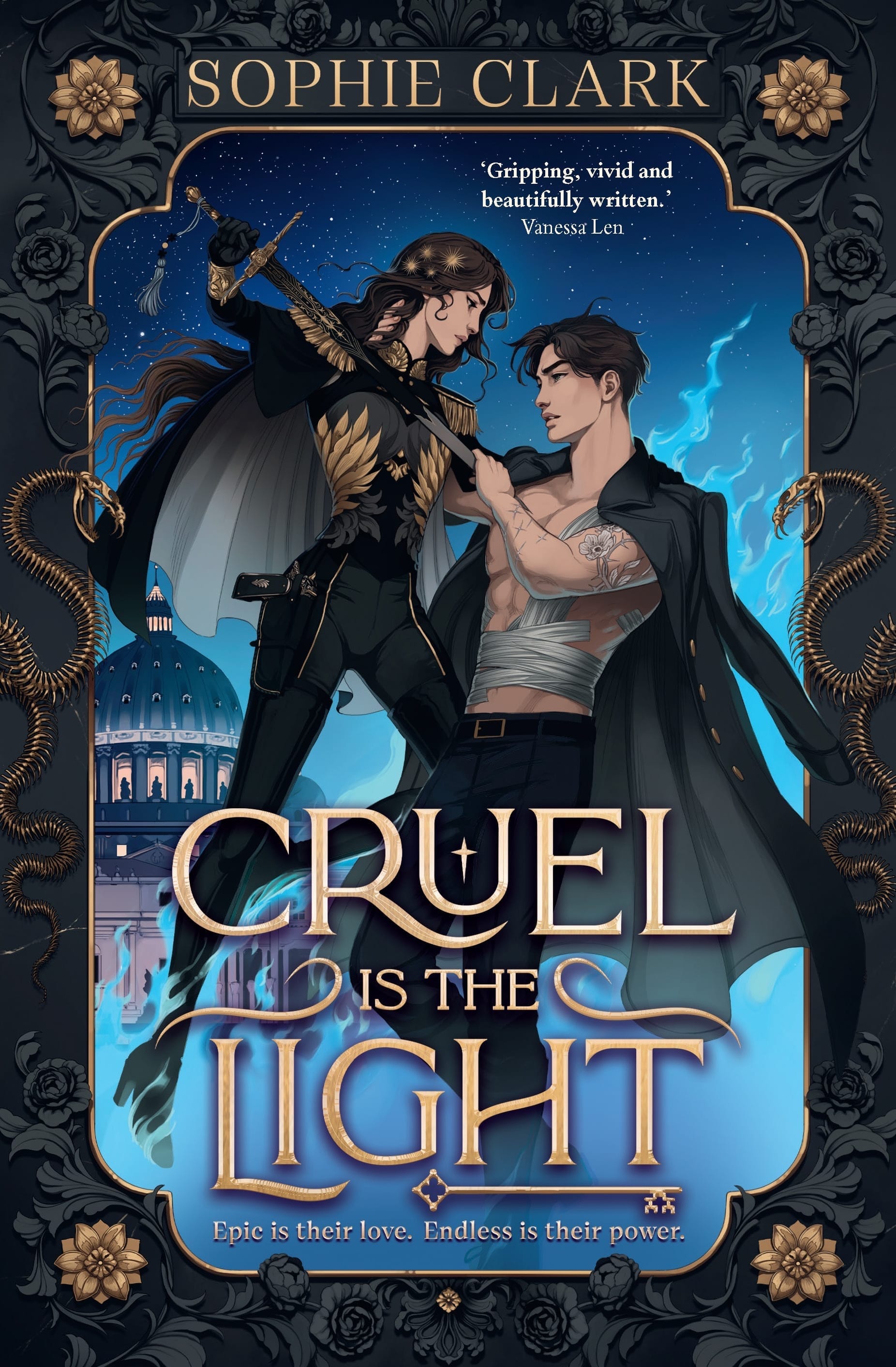Author: Sophie Clark
Published: 2025
Target audience: Teenagers 16+
Ever since the Deathless God was wounded defending humanity, a brutal war has raged in Europe between humans and demons for over a century. In the midst of this, two lives collide. Selene Alleva is a powerful Vatican-trained exorcist, known as the Butcher of Rome for her ruthless and bloody efficiency at slaughtering demons. Jules Lacroix is a solider and orphan trying to uncover his past.
Their paths cross when Jules is caught in a confrontation between Selene and the demon duke she has been hunting, Baliel, only for Jules to be completely unharmed by the demon’s destructive flames. Despite their initial mistrust - and then unexpected attraction - Selene and Jules must work together to track down Baliel and discover why the demons are targeting Jules.
But something is rotten in the heart of the Rome, and as they draw closer to the Vatican’s dark secrets, Selene and Jules realise the truth may lie in their own pasts…
Synopsis
‘Cruel is the Light’ is a young adult romantasy and debut novel of Australian author Sophie Clark. It is an enticing tale promising a star-crossed, enemies-to-lovers romance set in a world where demons and humans clash; where magic is carved into flesh and bone; where Selene and Jules will be forced into an impossible choice between love and duty. However, despite the story’s exciting vision, ‘Cruel is the Light’ stumbles in execution, resulting in a book weakened by ineffective characterisation, an underdeveloped romance, inept trope usage, and poor pacing.
Characterisation
The characterisation in ‘Cruel is the Light’ is lively and intriguing, but incomplete, resulting in the relationships feeling watered-down. On one hand, Jules is an undeniably engaging protagonist. He has a personal goal to actively pursue in wanting to find out where he comes from, why he was abandoned as a newborn, and why the enemy is interested in him. His motivations are clear and established, have concrete trigger moments that set his quest in motion, and shape his decisions in ways that are comprehendible and relatable. It must be noted, however, that the sheer number of coincidental meetings and fortuitous happenstances required to propel his journey occasionally borders on the ridiculous. Additionally, many readers will be able to quickly deduce much of Jules’ heritage and may find it tedious waiting for the main characters to reach the same conclusion hundreds of pages later. Yet despite these detractions, Jules remains an entertaining and varied character that will keep audiences entertained.
In comparison, Selene doesn’t have a character arc. Her introduction as the Captain of a demon-hunting squad on a mission is dynamic and gripping, and her fear of overusing her magic and being corrupted by it is genuine and sympathetic. Selene’s magic differs to other exorcists as the symbols are carved into her bones rather than skin, and each time she uses it a piece of her soul is consumed. However, this not a new issue for Selene; it’s something she has known about and managed for years. Therefore, repeatedly bringing it up for the audiences’ sake becomes tiresome as it offers no new information, nor does it give any insights into Selene’s current wants, needs, or motivations as a person. She’s been tasked with hunting down Baliel, and so meeting Jules and everything that follows is just her doing her job like always. She has no personal goal to pursue, no lessons to learn, no problem to solve. Out of the context of her relationship with Jules, there is little reason for readers to become emotionally attached to her as an individual.
Furthermore, despite the protagonists and majority of side characters being soldiers and militant exorcists, everyone comes off as a thoughtless teenager. Every interaction involves smirking, flirting, posturing, sulking, innuendos, and social jostling. This undermines tense scenes because if the characters aren’t taking the situation seriously, why should the reader? It also adversely affected the romance between the leads as their interactions don’t seem unique to them. Jules flirts with everyone and Selene is standoffish with everyone. Audiences may be left with the impression that had Selene been swapped with a different character as the love interest - such as Florentina, Lucia, or even Sparrow - the same romantic development with Jules would have occurred. There is unfortunately little that is inherently special or personalised to Selene and Jules' relationship for audiences to become invested in. Even the book’s vague tagline of “Epic is their love. Endless is their power” demonstrates a lack of substance to the narrative and romance.
Tropes
The critical failing of ‘Cruel is the Light’ as a romance novel is that it does not earn the tropes it’s trying to use. The novel is explicitly marketed as a tantalising enemies-to-lovers story bolstered by other complimentary tropes, including a forced proximity situation. This direction is flawed from the beginning however, as the story fails to adequately set up Selene and Jules as opposing entities or adversaries. They don’t hate or credibly dislike each other, nor do they have core ideological differences or misconceptions to overcome. In fact, they actually start on the same side of the human-demon war, with Selene as an exorcist and Jules as a solider who has been fighting demon hordes for the past four years.
Far from being enemies, their initial meeting could be simply described as a police officer detaining a suspicious individual at the scene of a crime, who then work together for mutual benefit. After witnessing Jules be unaffected by Baliel’s destructive flames, Selene strong-arms Jules into cooperating through a mix of the threat of being arrested and the appeal of uncovering answers about his heritage. They then proceed to be snarky towards each other and soon become steadily more physically intimate. This doesn’t qualify as enemies-to-lovers in even the loosest sense and would be more reasonably categorised as an instalove or instalust story. As ‘Cruel is the Light’ fails to evoke a believable adversarial foundation between the leads, nor capitalises on the instalove narrative actually unfolding, readers are consequently robbed of the sizzling tension of a well-executed enemies-to-lovers story as well as the fun of a whirlwind romance.
A second key trope utilised in this book is forced proximity. The strength of this trope comes from putting diametrically opposed characters in unfamiliar situations or social dynamics that forces the two to cooperate and communicate in ways they have never had the opportunity to before. There are many variations of this trope (e.g. buddy cop movies, reluctant roommates, being assigned to work on the same school project, etc) and while it is not exclusive to the romance genre, forced proximity blends well with other romance tropes (e.g. enemies-to-lovers, friends-to-lovers, fake dating, grumpy & sunshine, there’s only one bed, etc). The forced proximity trope enables the characters’ relationship to develop in ways it otherwise never would have.
This trope first manifests after Selene and Jules’ encounter with a demon duke and they must travel to Rome to find answers. Along the way, their train is delayed and they are trapped in the carriage together. However, they don’t have any tense personal history to whet a reader’s anticipation, or inherent conflict that is heightened by their involuntary closeness: they are strangers who just met, and they are temporarily stuck on a delayed train for a few hours. This is a commonplace setting and situation that many readers will likely have personally been in. This is not a desperate or unusual circumstance that would prompt any interaction between Jules and Selene other than discussing the recent demon attack or how they will sneak Jules into the Vatican. Therefore, when they start asking and answering deeply personal questions, it feels unnatural given the sum of their interactions up to this point.
This sense of artificiality is reinforced throughout their train journey when at different points Jules and Selene touch the other in an unprompted and unreciprocated manner, and at one point the train breaks abruptly causing Selene to land in Jules lap and squirm to get back up. Though intended to heighten sexual tension, such moments undercut believability and disrupt reader immersion due to the unrealistic nature of these events. Furthermore, having Jules pose as Selene’s estranged fiancé, Eliot, in order to gain entry to the Vatican is extraneous. While it is beneficial in enabling Jules to access restricted areas and fosters opportunities for Selene and Jules to grow closer by having to share a room and acting lovey-dovey in public, this decision creates more problems than it solves. In the Vatican, they are surrounded by former classmates who immediately want to reconnect with ‘Eliot’ after his seven-year absence, and they draw the attention and suspicion of Selene’s uncle - one of the highest ranked people in the Vatican and the man who banished Eliot. All these elements should combine for a thrilling tale of slowburn romance, political intrigue, and fantastical world-building. Unfortunately, the weak execution of all the additional conversations, secondary characters, and semi-pretend public flirting required to service this fake-relationship-turns-real storyline only worsens the book’s already lengthy page count and belaboured story progression. Ultimately, Selene and Jules’ illogical decisions come across as contrived attempts to force an intimacy that their interactions and the story haven’t earned.
Pacing and Structure
Finally, the creative potential of ‘Cruel is the Light’ is undermined by poor pacing and flawed narrative structure. The story opens with a prologue in which the demon duke Baliel crosses into the human world and razes a village. However, given the lack of context or stakes, rather than introducing Baliel as a powerful inhumane threat, he comes across as cartoonishly villainous in destroying things the audience does not care about. Worse, despite being not even two pages long, the prologue is written in such as haphazard manner that it breaks immersion and begs the question of if it is even necessary. Clunky phrasing and melodramatic language are reoccurring issues through the book, and is disruptive to the audience’s experience when we have to stop and re-read sentences for clarity.
The novel also suffers from being too long and laborious. Despite many individual events occurring, the overall narrative pace and romantic development is slow and unfocused, and arguably would be significantly improved by cutting up to a third of the book. The removal of inessential scenes, repetitious lines, and unnecessary world building would streamlined the novel, bolster audience engagement, intensify the love story, and speed up the character getting to the same reveals and realisations that many readers have already deduced. With concerted trimming, Cruel is the Light’ would become a great read.
Conclusion
‘Cruel is the Light’ has interesting world building concepts, distinct and lively characters, and a great premise, but disappointedly struggles to deliver on its promises. Yet despite its flaws, is not a terrible book and will please many romantasy readers. While this is not one I personally enjoyed, if you are a fan of ‘Fourth Wing’, ‘Serpent and Dove’, or ‘Powerless’, then this book may very well be your new favourite romantasy of 2025.
Excerpt:
‘Who are you really, Jules Lacroix?’
The question caught him with the force of a bullet. ‘Me? Nobody. An orphan. A soldier.’
‘Liar,’ she shot back, using his own accusation against him.
‘I’m not lying,’ he snarled. Stigmajka.
His body moved before he knew what he was doing, long strides eating up the cabin between them. He gripped her chin in his hand, his fingers feeling impossibly rough against her skin.
Her eyes flared with something very close to triumph. Grief and anger swept through him, making him ache to grasp a sword.
Dieu, I really am a monster, aren’t I?
‘I, too, want to know who I am.’

